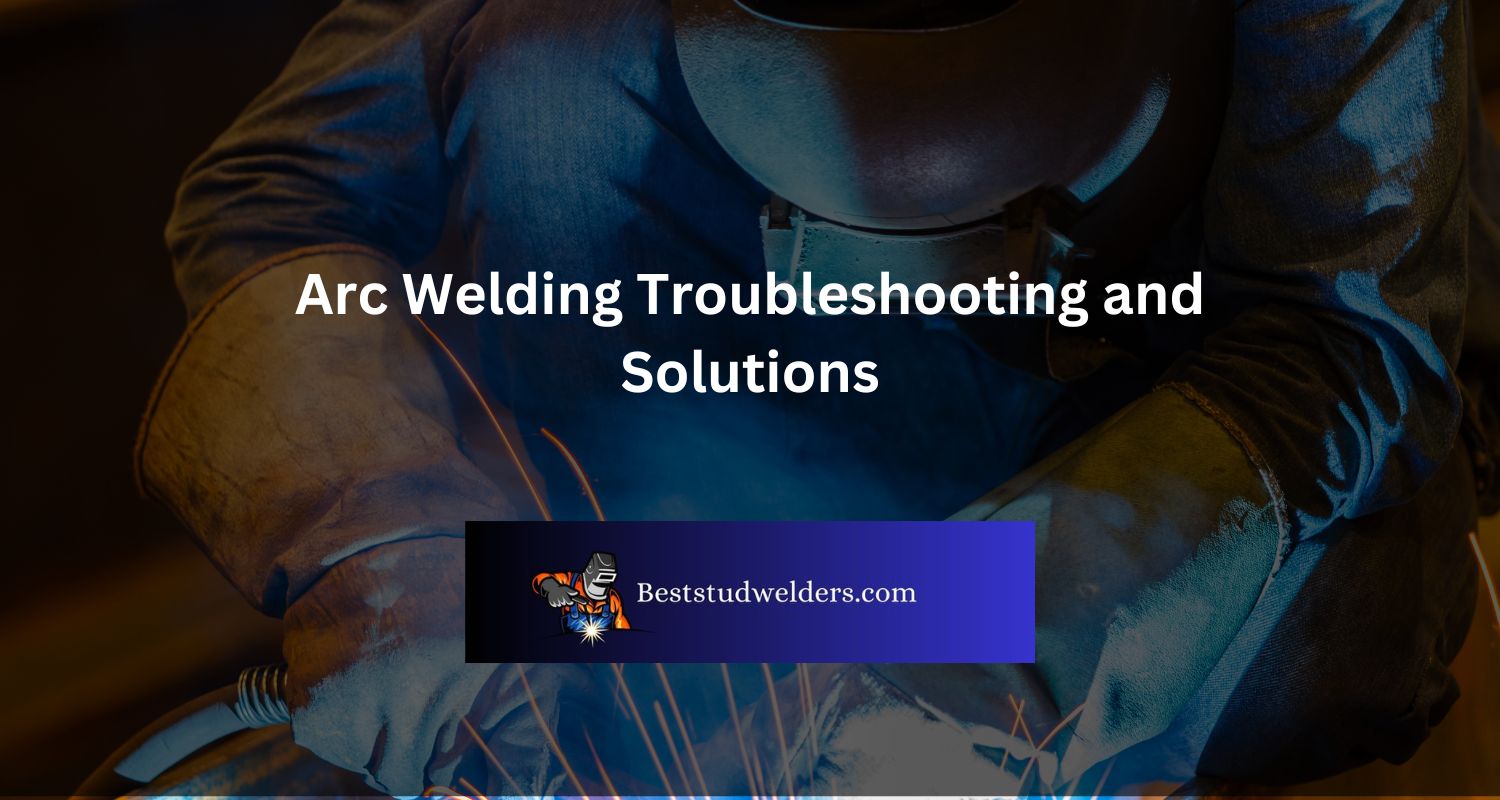Arc welding is a process that involves connecting two pieces of metal together through the use of electricity and extreme heat.
Although it may seem simple, there are many factors to consider when arc welding from environmental conditions to hardware selection all of which can lead to issues with your welds if not taken into account.
In this blog post, we’ll discuss common arc welding troubleshooting techniques and solutions for ensuring strong, high-quality welds every time.
Read on as we dive in and explore the world of arc welding!
Common Arc Welding Problems
To help you overcome common arc welding problems, the section on Common Arc Welding Problems in ‘Arc Weld Troubleshooting’ covers various sub-sections such as Poor Weld Quality, Electrode Sticking, Spatter, and Arc Blow.
Each sub-section focuses on a specific cause and solution related to welding issues that you may encounter during your welding process.
Poor Weld Quality
Welding Seams of Quality
Seams not up to standard can be risky. Issues can come from a lack of welder skill or incorrect techniques. It is important to avoid welding failures, which lead to a lack of adherence.
Before welding, safety must be considered and the metal looked at. It should be cleaned, rust-free and free of oil.
It helps to know different welding methods. MIG, TIG and Flame/Cut-Oxyacetylene can be better than only using one.
Welders and technicians need to be experienced and skilled. Certification confirms they follow regulations.
The article “A Vibration Analysis Tool for Teaching GMAW Techniques” by L.Timperley et al. states that welding procedure development focuses on parameter selection. This can result in cost savings and enhanced performance.
Undercutting
Undercutting due to over-welding is a phenomenon. It weakens the structure and makes it vulnerable to fractures. Overheating and unsuitable welding parameters lead to it. Six signs of undercutting are:
- Grooves or depressions along weld surfaces
- Unstable weld pool
- Weld bead thinner than adjacent metals
- Fragile angle in fillet welds
- Porosity around depression in groove welds
- Increased slag inclusion in weld deposit near undercut area
Welders must stay within heat input limits and use correct settings. Automated machinery must have strict controls. Human oversight is necessary for inspection. Quickly identify undercuts and take action. Before machining or welding, check materials for abnormalities. This way, manufacturers can make high-quality products.
Porosity
Porosity in Arc Welding! What is it? Porosity – tiny pores or holes in the joint. This can weaken the weld and change its look.
Look at the table below to find out what causes it:
| Factor | Description |
|---|---|
| Gas coverage | Not enough gas coverage – this leads to Porosity |
| Base metal | Impurities in the base metals cause Porosity |
| Electrode | Moisture on the electrode surface = Porosity |
| Welding speed | Fast welding speeds create Porous welds |
Contamination of the filler material, not cleaning the base surfaces well, and wrong welding techniques also lead to Porosity.
Pro Tip: Always make sure there’s enough gas coverage and clean the base materials before you start welding.
Incomplete Fusion
Partial Joint Penetration is when metal joining fails to create complete fusion. This is caused by inadequate heat input or improper electrode tilt and position.
Weak joints and brittleness result from inadequate heat input. To fix this, increase heat input and adjust arc length.
Lack of fusion between parent material and filler metal results from improper electrode tilt and position. Adjust electrode angle and welding technique to remedy this.
To prevent this issue, pre-welding cleaning of the surface area and selecting the correct filler metal is crucial. Additionally, skilled welders must adjust themselves based on welding positions like horizontal, vertical or overhead. They must also adjust amperage settings accurately.
Electrode Sticking
When an electrode is attached to the metal surface, rather than melting in, it’s known as ‘electrode adherence’. Here’s a 5-step guide for resolving it:
- Lessen the amperage and extend the arc.
- Clean the base metal before welding.
- Sharpen or change electrodes to avoid oxide accumulation.
- Set the electrode’s angle between 5-15 degrees in the direction of travel.
- Use the right welding technique with ideal current and voltage settings based on its size.
Also, track the stickiness and pace of the electrode. Don’t tap the rod against the joint or base material. Mastering the craft requires practice and following standard methods. Neglecting them can lead to dangerous scenarios affecting health, property, and equipment. It’s essential to be mindful of various welding issues, as they can be a serious hazard. Pay heed to signs like cracks, spatters, porosity, undercutting, warping, etc., which show upcoming problems.
Spatter
Weld spatter are tiny metal droplets that scatter during welding and cause a range of issues. This includes damage to equipment, undersized welds, and the need for post-weld cleaning.
Oxidation of these spatters can make it tough to clean surfaces, and even cause health hazards due to toxins. To avoid this, techniques like reducing amperage or using anti-spatter sprays can be used. Gun nozzle position also helps in reducing sparks while welding.
Pro Tip: Applying an anti-spatter solution and oxygen inhibitors like glass beads around surfaces can reduce friction and droplet formation.
.jpg)
Arc Blow
Welding defect, known as magnetic distortion, is caused by the interaction of the welding arc and nearby metal objects. This results in an arc deviation from the planned path, causing faulty welds or cracks. Voltage issues would also occur, making it hard for welders to craft perfect work. To counter this, welders use poles with special alloys that lower magnetic field interference.
Ferromagnetic materials are the main culprit for this welding imperfection. If ignored, other defects like arc instability and porosity will arise. As a workaround, welders could ground metal objects and clamp them down during welding.
If you are dealing with “magnetic blowout”, don’t move too much. Try changing grounded clamps or varying pole distances.
Pro Tip: Before starting any welding activity, always scan your environment for any sources of interference.
Causes of Arc Welding Problems
To solve arc welding problems caused by a multitude of factors, this section will discuss the possible solutions to different sub-sections, namely, incorrect voltage settings, incorrect welding techniques, poor weld joint preparation, and contaminated base metal or electrode.
Incorrect Voltage Settings
A wrong voltage setup can cause many arc welding difficulties. If the proper voltage is not used, weld quality and strength will suffer and redo is needed.
- Make sure to read manufacturer’s voltage suggestions and adjust your power supply in line with those.
- Pick a suitable electrode size for the welding you are doing.
- Keep an eye on voltage levels during use to make sure they remain steady.
- Investigate any voltage difference without delay to prevent further problems.
Besides, pay attention to other aspects such as inadequate base material preparation or insufficient shielding gas/gas flow rate.
A colleague once experienced a project that required welding some tough materials, but forgot to examine voltage settings of the power supply beforehand. The result was numerous porosity, brittleness, and weld bead cracking issues, which made the project timeline longer due to the need for repair and rework.
Incorrect Welding Techniques
Welding has many techniques to get it right and avoid problems. Wrong welding procedures, like wrong electrode choice, incorrect angle position, and wrong heat settings can cause welding issues. So, welders must know the basics well and practice a lot.
Weld puddle manipulation done wrongly also causes issues. Uneven fusion and weak welding can result. So, welders must be careful when handling the molten metal and keep the weld puddle stable.
Moreover, welders need to stay alert and free of distractions while working. Arc welding needs a lot of attention. Even small interruptions can affect the weld quality.
To prevent arc welding issues, practice with the right technique and concentrate on keeping the weld puddle steady.
Poor Weld Joint Preparation
Maximising Arc Welding: Preparing the Weld Joint.
It’s vital to get the weld joint ready before arc welding. Poorly prepared joints can lead to weak welds, reducing mechanical strength and risking failure.
Factors like uncleanliness, incorrect fit-up, inappropriate joint design or dimensions can cause bad weld joint prep. For instance, lack of cleaning can introduce contamination in the base metal or filler wire, leading to poorly fused joints.
To avoid this, take steps like:
- Thoroughly cleaning away dirt and rust
- Accurately aligning edges for a proper fit-up
- Checking dimensions meet requirements
Pro Tip: Make sure the welding surfaces are clean and free from contaminants. Always take safety precautions when preparing the perfect weld joint.
Contaminated Base Metal or Electrode
Base metals and electrodes that are dirty can cause arc welding issues. Impurities on these surfaces could result in weak joints, air pockets, and cracking. Rust, from contact with water or the air, could make a boundary between the metal and the electrode, causing the weld to be feeble. Grease or oil on the metal’s surface will stop proper attachment from occurring.
The following table shows common contaminants during Arc Welding:
| Contaminant | Effect on Weld Quality |
|---|---|
| Rust | Weak welds no fusion |
| Oil/Grease | Poor adhesion of materials |
| Paint/Oxides | Air pockets in welds |
| Arc Striking Residue | Trouble starting/maintaining arcs |
It is essential to ensure that applied coatings are up to industry standards. Low quality coatings may damage welding results.
Electrodes must be handled correctly, as they can quickly get dirtied. All electrical items have to be in good condition for proper functioning.
I recall a colleague having difficulty with welding. After analyzing, the base metal was not cleaned thoroughly before starting, with oil and grease residue left over from production. After cleaning properly, the weld quality improved.
Troubleshooting Arc Welding Problems
To troubleshoot arc welding problems with Arc Weld Troubleshooting, you need to know the solutions for common issues such as undercutting, porosity, incomplete fusion, electrode sticking, spatter, and arc blow.
Solution for Undercutting
To avoid weak, brittle welds from too much indentation, do the following:
- Check the angle of the welding torch. It should be tilted properly.
- Keep a steady speed when welding. No speeding up or slowing down.
- Lower current and voltage if needed.
- Use a filler metal fit for the welding type and conditions.
- Thin edges before welding, to stop excess pooling.
It’s also really important to keep the working area clean, including all tools and surfaces used for welding.
If there’s undercutting in an arc welding project, take corrective action fast, or else you may have a structural failure.
A welder once had undercutting in an iron casting project for heavy machinery parts. Upon closer inspection, they saw that dirt had collected due to no cleaning of the base metal before welding. This, combined with bad heat control, caused serious issues later on.
Solution for Porosity
Getting rid of porosity in arc welding is key for a perfect weld. This guide provides tips to prevent porosity from occurring.
- Checked electrode selection and storage.
- Cleaned and prepped base material before welding.
- Tweaked wire speed, current range and voltage for the right weld bead size.
- Used another shielding gas or worked at a reduced flow rate of the existing gas.
- Rechecked joint design and fixture setup for proper fit-up and no air entrapment.
Operator technique can also cause porous results.
After Step 2, an extra tip would be to make sure there are no surface contaminants. Clean surfaces create better bonding between base metal and electrode. It’s cheaper than buying industrial cleaner solutions.
Metallurgists saw sub-surface hydrogen pores ruin the cast iron filler metal’s look during thermal processing. They discovered that undetected water sources were causing hydrogen contamination in molding sand & impregnation processes. With teamwork, they figured out the problem areas and production continued.
Solution for Incomplete Fusion
To avoid incomplete fusion in arc welding, follow some simple steps! These will not only eradicate the issue, but also ensure successful welding outcomes.
- Adjust the current and voltage settings based on the thickness and type of material.
- Select the right electrode size and type for the job.
- Keep a steady arc length and travel speed when welding.
- Ensure clean surfaces by removing rust or dirt before beginning.
Remember – even minor changes from the best practices can lead to faulty welds. Adopting these steps can save time and yield great results.
Don’t let incomplete fusion issues ruin your welding projects. Follow these guidelines for successful arc welding outcomes!
Solution for Electrode Sticking
Electrode sticking during arc welding can be super annoying! But there are ways to tackle it. Here’s a 5-step guide:
- Select the right electrode size for the process;
- Clean the metal surface before welding;
- Tweak the amperage settings to reduce sticking;
- Apply anti-stick coatings on electrodes;
- Try TIG or MIG welding if needed.
Check all equipment before welding and brush up on techniques. Get some training if possible too.
Solving the electrode sticking issue takes care and thought. Follow the steps above and invest in maintenance and training – it’ll help minimise the problem.
Welding Productivity Magazine warns, “UV radiation from arc strikes between electrode and metal can cause short-term and long-term pain.”
Solution for Spatter
Spatter is a universal issue welders face. To dodge it, a few tips and tricks are available:
- Adjust welding parameters – To stop spatter, the right voltage and amperage must be chosen. Appropriate settings will make sure the weld pool is created correctly, which also helps reduce spatter.
- Cleanliness – Clear off grease, oil, or dirt from the surface before welding. This will lead to better arc stability and less chance of spattering.
- Anti-spatter agents – Utilize anti-spatter sprays or paste on the workpiece or filler metal. This serves as a shield between the metal and atmosphere, preventing oxidation while controlling the radiation produced during welding.
Plus, some welders suggest certain electrodes or wire feed rates for diverse applications to minimize spatter.
Pro Tip: To get the best results, you should always experiment with different methods and figure out which works best to control spatter.
Solution for Arc Blow
Wanna resolve Arc Blow issues? Here are 3 steps to help:
- Firstly, choose a thick and high-quality electrode for stability.
- Secondly, use magnetic devices to position yourself perpendicular to the electric field.
- Lastly, try shielded metal arc welding (SMAW).
Remember: it’s not always electrical storms that cause Arc Blow. Misaligned clamps & bent conductors can too! I once had an Arc Blow problem while welding a big pipe for an oil company. Lightning shot out from the rod in the middle of my weld! It took ages to clean up and start again.
Frequently Asked Questions
What are some potential causes of poor weld quality?
Poor weld quality can be caused by a variety of factors, including improper weld settings, incorrect electrode selection, inadequate shielding gas, dirty work surfaces, and improper technique.
How can I prevent spatter during arc welding?
Spatter can be prevented by properly selecting and adjusting the welding parameters, ensuring that the work surface is clean and free of contaminants, and using the correct electrode type and size.
Why might I be experiencing porosity in my welds?
Porosity can be caused by a variety of factors, including inadequate shielding gas, moisture or contaminants in the electrode or filler material, or improper technique. Checking and adjusting these factors can often resolve porosity issues.
What should I do if I notice cracking in my welds?
If cracking is noticed in welds, it is important to identify and address the underlying cause. This may involve adjusting welding parameters, using a different electrode type or size, or correcting any issues with the workpiece.
Paul Dixon is a certified welder with a wealth of experience in welding and related technologies. He started his career as an apprenticeship in welding, where he learned the ropes and acquired extensive skills in the craft.
Over the years, Paul has continued to sharpen his expertise, earning him top-rated welding certification. He remains one of the most outstanding welders in the industry.







